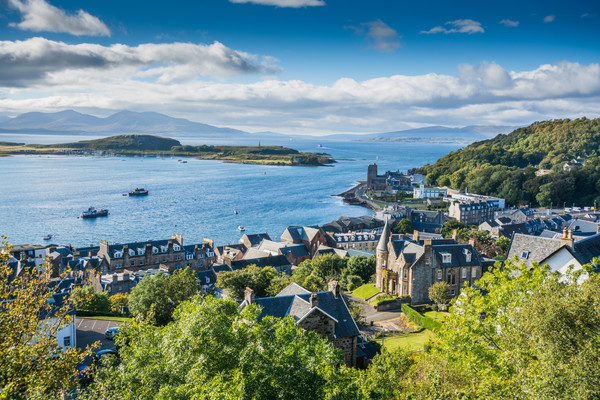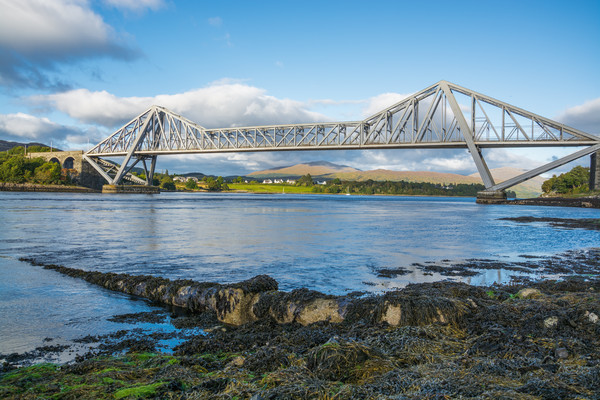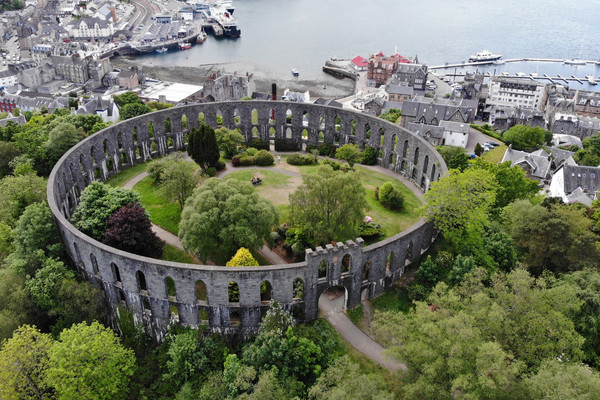Oban – Gateway to the Western Isles
By Mike Deegan, Head of Fleet Operations
Oban has long been our base in Scotland and served as our turnaround port on the West Coast for many years until a 3-year, Covid-induced interruption since 2020. From 2023 however we shall return to our spiritual home in the west of Scotland so I thought I would detail some of its many attractions to whet your appetite as we prepare for our next Hebridean season.

I feel sorry for Oban – like most ferry ports it is somewhere people pass through on their way to somewhere else. However like its English counterpart in this respect, Dover, there is much to like about this charming town and its surroundings. I was first introduced to Oban over 40 years ago when as an Officer Cadet in the Merchant Navy serving aboard a general cargo vessel I was sent ashore by boat as we passed to purchase the daily papers for the Master along with other essential items for crew members! This would have been part of my duties as SLJO (Silly Little Jobs Officer!) although the opportunity to hop ashore and explore meant I never had to be asked twice! I have never been sure why but Mars Bars (other chocolate bars are available!) featured large in everyone’s shopping lists along with shampoo, ginger biscuits, some screws and other consumables for the Chief Engineer. I recall with deep respect the Bosun on that particular ship : Gerry Edwards. One of life’s true gentlemen and characters : he required the Times as he loved the crossword so if I could get some back numbers (easy in a town like Oban where collections of unsold editions were only made weekly) my star was in the ascendancy which was never a bad thing with such an important man as the Bosun on board! That said, such was his world-weary view of life in general that whilst I may have scored a few brownie points, I was never in credit with him and my account, indeed the account of all the Cadets, was only ever in debit. Despite being held in such low esteem (!) we all learned how to be superb practical seamen under his expert, watchful, if slightly jaundiced, view of us and our career aspirations! I have oft mused since that informed cynicism is no bad thing”!
But I digress….Oban. Even back then as a young man learning to be away from home, Oban was a world away from normal life and routine existence on a ship. It was bustling, pretty and had a clean air about it not to mention a promenade with spectacular views across to the Isle of Kerrera opposite and smart shops, a scenic backdrop and small shacks selling all manner of local seafood and delicacies of which more later.
For those who have not visited yet, Oban is one of the largest towns on the Scottish West Coast and about halfway between Helensburgh to the south and Fort William to the north. Our transfer coach from Glasgow takes the scenic “Rest and be thankful” road via Inverary and the last part of that route, from Tyndrum is worth staying awake for! It slopes gently down towards the sea and passes the mighty Loch Awe, a huge body water (on your left when route TO Oban). This freshwater loch is the third largest freshwater loch in Scotland but the longest at 25 miles from end to end. At the seaward end is the Cruachan hydro-electric scheme. The scheme consists of a man-made top pool high above the road on the landward side of the road (the mountain is Ben Cruachan) into which water is pumped at times of low electrical demand then released back into the loch through a tunnel running through the mountain at times of peak demand. That impressive looking mountain is actually hollow for the most part and houses 4 turbines / generators which the descending water passes through to produce 440MW of power. Scotland is rightly proud of its sustainable energy drive but this scheme is not new : it was constructed in the 1960s and has been providing power to the National Grid ever since. Just past the buildings housing the lower parts of this scheme is slightly smaller Awe Barrage hydro-electric scheme formed by a dam between Loch Awe and the adjacent Loch Etivie – water is passed down a tunnel between the two lochs and this in turn powers a rotating generator at the Loch Awe Power Station. Unless you knew the schemes were present locally in this remote location, you would think for all the world there could be nothing so vulgar and man-made as you pass through this spectacular and unspoilt terrain.

Connel Bridge at the falls of Lora
The lands around Loch Awe were Clan MacArthur and Clan Campbell lands and it was just downstream from here the Battle of the Pass of Brander occurred at which King Robert the Bruce defeated the MacDougalls. It is impossible to determine the exact date of the battle but late 1308 or early 1309 seem most likely. You will pass Dunstaffnage Castle on the approach to Oban further down the road – look out for it on the right after you pass under the spectacular Connel Bridge – of which more shortly. This was the MacDougall base and from where an ailing Clan Chief, Alexander McDougall, waited for news of the battle from his son who led the MacDougall hordes. When it came it was all bad!
As you continue the journey, look out for the herds of Highland Cattle (known locally as the Heeland Coo) and Deer farmed locally – they abound on both sides of the road. As the road levels out at the seaward end of Loch Etivie you approach the village of Connel on the outskirts of Oban. You will pass under the aforementioned Connel Bridge – an amazing cantilever structure that carries the start of the road to Fort William over the road to Oban below. As its look suggests it was built originally as a railway bridge which carried a branch line over the water. It was designed by John Wolfe Barry, son of the famous architect Charles Barry, and if you think you have heard that name before – you have! Along with Henry Marc Brunel (son of Isambard) John was the Engineer that oversaw the construction of Tower Bridge in London. The Connel Bridge was constructed of 2,500 tons of steel and opened in 1903. When it opened it boasted the second longest span of any railway bridge in the country after the Forth Bridge. Just 6 years later in 1909 a single-track roadway was added on the seaward side. However the structure could not carry road and rail simultaneously so level crossing style gates were installed at either end when a train was crossing. Dr Beeching decreed that the line be closed, which it was in 1966, since when the bridge has been a single-track road bridge with traffic lights at either end.
As you look up and marvel at the engineering genius that was able to conceive such a bridge in the early part of the 20th century, take a moment to look under the bridge at the confused water rapids. These are the Falls of Lora and are more correctly described as a tidal race. They form over a sub-sea rocky shelf when the levels on either side of the narrows are different as the narrow entrance to Loch Etivie to the east does not allow the water level in the Loch to fall quite as rapidly as the water level in the sea loch to the west as the tide ebbs. Conversely as the tide floods, it cannot pass over the rocky ledge just under the water here and through the rapids under the bridge quickly enough into Loch Etivie. For this reason there are two peculiar local phenomena. Firstly the tidal range either side of the falls are different : on the seaward side a tidal range of 3m only produces a 1.3m tidal range in Loch Etivie. For those of you who have travelled extensively with Noble Caledonia you may have seen a similar effect at the Horizontal Falls in Talbot Bay in the Kimberley region of NW Australia. However here it is for all to see on our own shores! The second peculiar phenomenon is that slack water at the Falls is not in the period between Low Water and High Water as is usual but for the short time the water level on both sides of the narrows is identical. Yachtsmen beware!
Shortly our coach arrives into Oban. From the sea front you can look across to the Isle of Kerrera opposite and which protects Oban from westerly winds which blow here in the Winter. Beyond is the Sound of Mull and the Isle of Mull – the largest Hebridean Isle. Kerrera only has an area of 5 square miles and a population of a little over 40 split into 2 communities which are situated at the north and south ends of the island. The island boasts a ruined 16th century castle, Gylen Castle, and was visited by the artist Turner whose sketches of Kerrera can be seen in the Tate Gallery in London. High above the town is the partially completed McCaig’s Tower. If you have time I strongly suggest a walk up to the monument. John Stuart McCaig was a local banker and philanthropist who commissioned the build to provide work for local stone masons and builders when another project locally was halted. The building was commenced in 1897 but stopped when Mr McCaig died in 1902 and was never completed. It is an impressive structure indeed with a circumference of approximately 650ft and 94 arches on its ground and first floors around its perimeter. McCaig took the Colosseum in Rome as his inspiration and had it been completed it would also have included a central tower, an art gallery and a museum. In the event only the outer walls were completed before his death. On the few occasions I have ventured up there, the quiet atmosphere in the well-maintained central gardens and spectacular views out across the Sound of Mull and across the Isle of Lismore and up Loch Linhe to the north make the exertion of walking up the hill very worthwhile indeed – and of course it is downhill on the return!
Oban was originally developed around its own distillery which was established in 1794. In fact the town took the name of the Whisky developed there - Oban. The name is thought to derive from the gaelic for “small rocky bay”. The distillery still produces Oban Whisky which has its own distinctive flavour described as “West Coast” and despite being owned by Diageo these days its production is modest with only 2 small pot stills in operation. You can see the historic distillery buildings just set back at the north end of the promenade.

McCraigs Tower
Oban is the major town in the region with residents of outlying villages visiting to shop in the supermarket – the only one for many miles in any direction. For many years well into the 20th century the town operated a dormitory house to accommodate children from the Hebridean Islands who travelled to Oban for school. They usually arrived in Oban on a Sunday evening by ferry and left again to sail home on Friday afternoon. Nowadays most of the island communities have their own schools including secondary schools of which they are four across the islands.
Despite it being relatively remote, Oban has good transport links. The A85 which we travelled down in our coach to get here connects Oban with the rest of the Scottish road network. Ferries sail from Oban to Kerrera, Lismore, Colonsay, Coll, Tiree, Barra, South Uist and Mull. My good friend Captain Ian Stevenson who commands one of the larger ferries operating out of Oban, tells me he has the best job in the World mainly because the view outside his office window is unparalleled but that sailing across the Western Isles in a Winter storm is not for the faint hearted! Ferry traffic increased after 2005 when the local ferry operator, Caledonian MacBrayne, which is wholly state owned as it provides lifeline ferry services to some of the most remote communities in the UK, commissioned a new ferry terminal and installed a second car ferry linkspan on Railway Pier allowing direct transfer for foot and cycle passengers between the train and ferry (direct services to Glasgow Queen Street). Incidentally an oft quoted ode loosely based on Psalm 24 would have us believe that the MacBrayne ferry company actually lays claims to the Hebrides:
Unto the lord belongs the Earth
And all that it contains
Except the Kyles and Western Isles
For they belong to MacBraynes
Just outside Oban at Connel (do you recall us discussing the bridge and the Falls of Lorn thereabouts earlier?) is a small airport but there are flights from there to many of the Hebridean Islands. When we are in Oban the Hotel Manager will be ashore to seek out the local delicacies (including a bottle of Oban Whisky) to give you a flavour of the area. Oban is a busy fishing harbour and Lobster and Crab from Luing, Scallops from Mull, Langoustines, Mussels, and Oysters from Loch Linhe as well as locally caught Monkfish, Halibut and Squid are all landed there and are local seafood products worth savouring. As we saw on our journey into Oban Venison is farmed locally as well as the Heeland Coo (I hope you are keeping up at the back!) Salmon too is farmed locally so all in all there is much to plunder for our busy Hotel Manager!
So I hope I have given you a flavour of Oban and its surroundings. If you have an opportunity tarry a-while and soak up the atmosphere of this pretty seaside town. I can definitely recommend a meal at one of the many seafood restaurants in the town and walks both along the sea front and up to McCaig’s Tower – in the latter case the views are just reward for climb. Oh yes and as they always say in these parts “haste ye back”!





